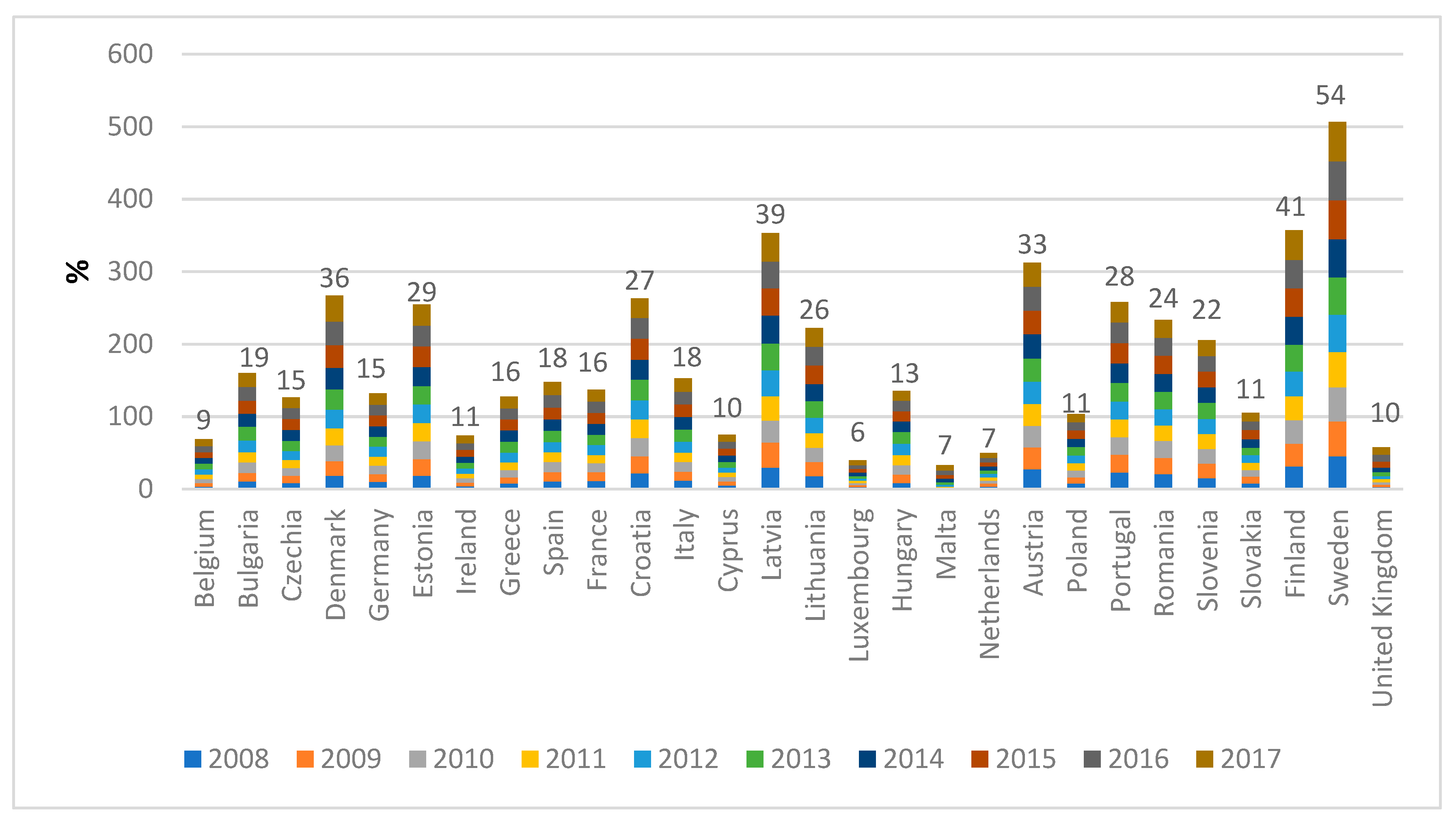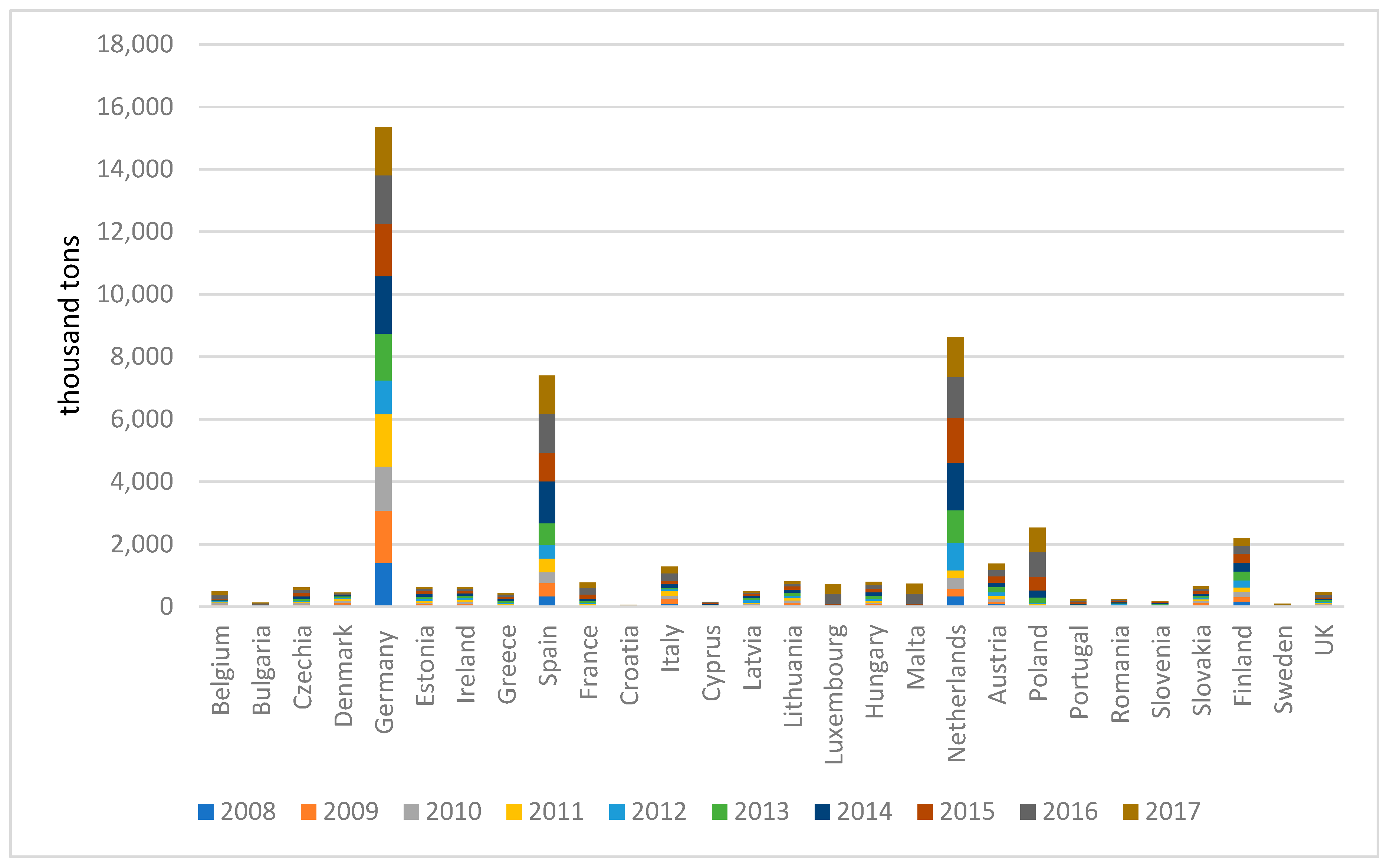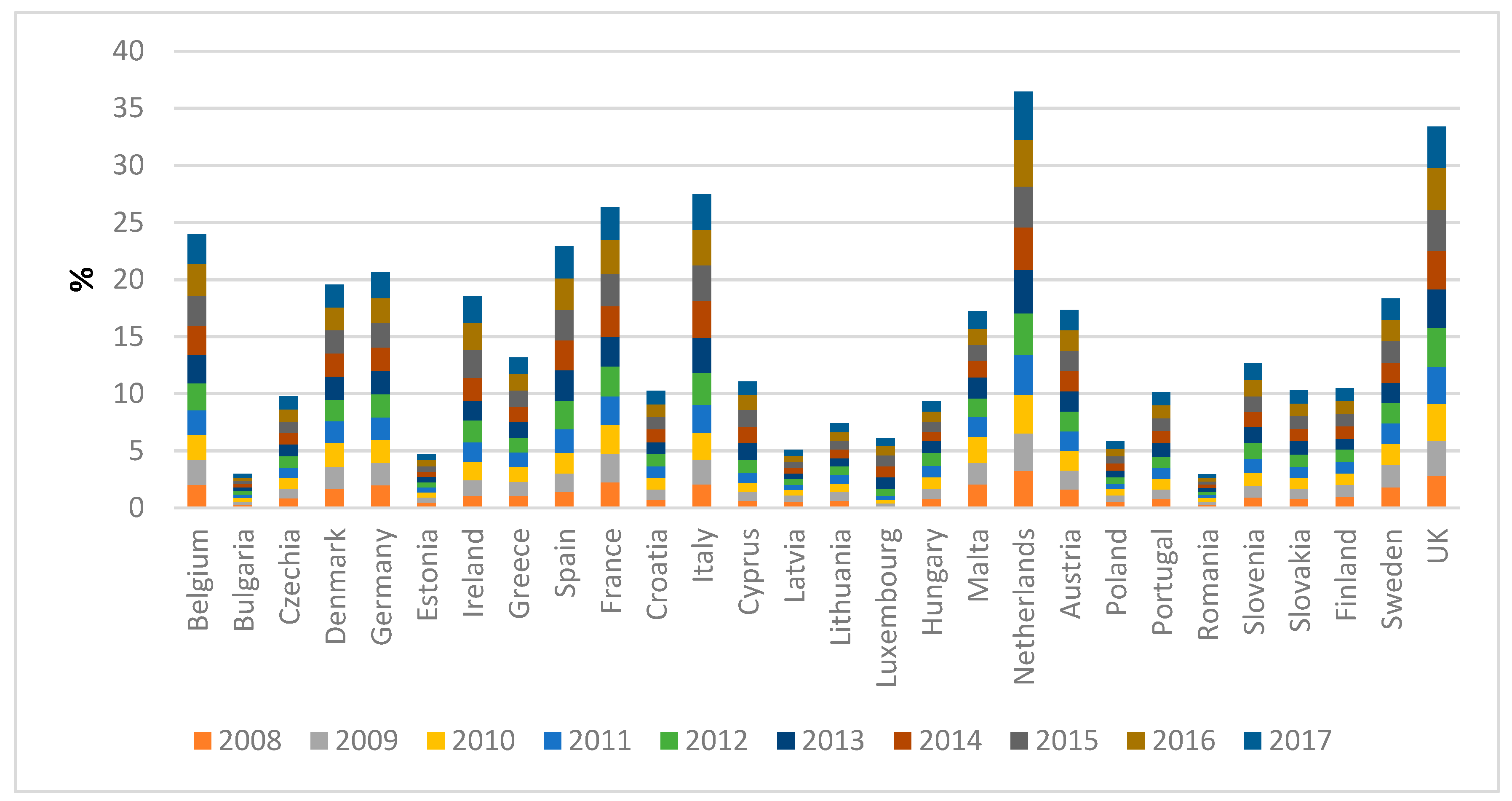The Role of Renewables in a Low-Carbon Society: Evidence from a Multivariate Panel Data Analysis at the EU Level
Abstract
:1. Introduction
2. Literature Review and Hypotheses Development
3. Research Method
3.1. Sample Description
3.2. Dependent and Independent Variables
3.3. Research Methodology
- Yi = the dependent variable;
- Xi = independent variables;
- αi, βi = parametric coefficients;
- ui = error term;
- .
- H0: There is no correlation between independent variables and unit effects;
- H1: There is a correlation between independent variables and unit effects.
4. Results
5. Discussion
6. Conclusions
Funding
Conflicts of Interest
References
- Eurostat. Available online: http://ec.europa.eu/eurostat (accessed on 30 June 2019).
- COP 21 Report. 2015. Available online: https://www.gouvernement.fr/en/cop21 (accessed on 5 September 2019).
- Aïssa, M.S.B.; Jebli, M.B.; Youssef, S.B. Output, renewable energy consumption and trade in Africa. Energy Policy 2014, 66, 11–18. [Google Scholar] [CrossRef] [Green Version]
- Poumanyvong, P.; Kaneko, S. Does urbanization lead to less energy use and lower CO2 emissions? A cross-country analysis. Ecol. Econ. 2010, 70, 434–444. [Google Scholar]
- Zhang, C.; Lin, Y. Panel estimation for urbanization, energy consumption and CO2 emissions: A regional analysis in China. Energy Policy 2012, 49, 488–498. [Google Scholar] [CrossRef]
- Martínez-Zarzoso, I.; Maruotti, A. The impact of urbanization on CO2 emissions: Evidence from developing countries. Ecol. Econ. 2011, 70, 1344–1353. [Google Scholar] [CrossRef]
- Kumar, B.; Asadi, M.; Pisasale, D.; Sinha-Ray, S.; Rosen, B.A.; Haasch, R.; Abiade, J.; Yarin, A.L.; Salehi-Khojin, A. Renewable and metal-free carbon nanofibre catalysts for carbon dioxide reduction. Nat. Commun. 2013, 4, 2819. [Google Scholar] [CrossRef]
- Dietz, M.E. Low impact development practices: A review of current research and recommendations for future directions. Water Air Soil Pollut. 2007, 186, 351–363. [Google Scholar] [CrossRef]
- Apergis, N.; Payne, J.E. Renewable energy consumption and economic growth: Evidence from a panel of OECD countries. Energy Policy 2010, 38, 656–660. [Google Scholar] [CrossRef]
- Shafiei, S.; Salim, R.A. Non-renewable and renewable energy consumption and CO2 emissions in OECD countries: A comparative analysis. Energy Policy 2014, 66, 547–556. [Google Scholar] [CrossRef]
- Heil, M.T.; Wodon, Q.T. Inequality in CO2 emissions between poor and rich countries. J. Environ. Dev. 1997, 6, 426–452. [Google Scholar] [CrossRef]
- Duro, J.A. Weighting vectors and international inequality changes in environmental indicators: An analysis of CO2 per capita emissions and Kaya factors. Energy Econ. 2013, 39, 122–127. [Google Scholar] [CrossRef]
- Dogan, E.; Seker, F. Determinants of CO2 emissions in the European Union: The role of renewable and non-renewable energy. Renew. Energy 2016, 94, 429–439. [Google Scholar] [CrossRef]
- Li, R.; Su, M. The Role of Natural Gas and Renewable Energy in Curbing Carbon Emission: Case Study of the United States. Sustainability 2017, 9, 600. [Google Scholar] [CrossRef]
- Busu, M. Adopting Circular Economy at the European Union Level and Its Impact on Economic Growth. Soc. Sci. 2019, 8, 159. [Google Scholar] [CrossRef]
- Gomiero, T. Are Biofuels an Effective and Viable Energy Strategy for Industrialized Societies? A Reasoned Overview of Potentials and Limits. Sustainability 2015, 7, 8491–8521. [Google Scholar]
- Salman, B.; Ong, M.Y.; Nomanbhay, S.; Salema, A.A.; Sankaran, R.; Show, P.L. Thermal Analysis of Nigerian Oil Palm Biomass with Sachet-Water Plastic Wastes for Sustainable Production of Biofuel. Processes 2019, 7, 475. [Google Scholar] [CrossRef]
- Hou, Y.; Iqbal, W.; Muhammad Shaikh, G.; Iqbal, N.; Ahmad Solangi, Y.; Fatima, A. Measuring Energy Efficiency and Environmental Performance: A Case of South Asia. Processes 2019, 7, 325. [Google Scholar] [CrossRef]
- Hsiao, W.L.; Hu, J.L.; Hsiao, C.; Chang, M.C. Energy Efficiency of the Baltic Sea Countries: An Application of Stochastic Frontier Analysis. Energies 2019, 12, 104. [Google Scholar] [CrossRef]
- Cucchiella, F.; D’Adamo, I.; Gastaldi, M. Future Trajectories of Renewable Energy Consumption in the European Union. Resources 2018, 7, 10. [Google Scholar] [CrossRef]
- Lage, S.; Gojkovic, Z.; Funk, C.; Gentili, F.G. Algal Biomass from Wastewater and Flue Gases as a Source of Bioenergy. Energies 2018, 11, 664. [Google Scholar] [CrossRef]
- Al-Esawi, N.; Al Qubeissi, M.; Kolodnytska, R. The Impact of Biodiesel Fuel on Ethanol/Diesel Blends. Energies 2019, 12, 1804. [Google Scholar] [CrossRef]
- Banga, J.R.; Menolascina, F. Computational Methods Enabling Next-Generation Bioprocesses. Processes 2019, 7, 214. [Google Scholar] [CrossRef]
- Busu, C.; Busu, M. How Does Renewable Energy Impact Carbon Emissions? An Eu Level Analysis. In Proceedings of the 11th International Management Conference “The Role of Management in the Economic Paradigm of the XXIst Century, Bucharest, Romania, 2–4 November 2017; pp. 502–510. [Google Scholar]
- Busu, M. Assessment of the Impact of Bioenergy on Sustainable Economic Development. Energies 2019, 12, 578. [Google Scholar] [CrossRef]
- Singh, N.; Nyuur, R.; Richmond, B. Renewable Energy Development as a Driver of Economic Growth: Evidence from Multivariate Panel Data Analysis. Sustainability 2019, 11, 2418. [Google Scholar] [CrossRef]
- Takeda, S.; Keeley, A.R.; Sakurai, S.; Managi, S.; Norris, C.B. Are Renewables as Friendly to Humans as to the Environment?: A Social Life Cycle Assessment of Renewable Electricity. Sustainability 2019, 11, 1370. [Google Scholar] [CrossRef]
- Kaya, Y.; Yokobori, K. (Eds.) Environment, Energy, and Economy: Strategies for Sustainability; United Nations University Press: Tokyo, Japan, 1997. [Google Scholar]
- Wu, C.; Liao, M.; Liu, C. Acquiring and Geo-Visualizing Aviation Carbon Footprint among Urban Agglomerations in China. Sustainability 2019, 11, 4515. [Google Scholar] [CrossRef]
- Dong, F.; Li, J.; Zhang, Y.-J.; Wang, Y. Drivers Analysis of CO2 Emissions from the Perspective of Carbon Density: The Case of Shandong Province. China Int. J. Env. Res. Public Health 2018, 15, 1762. [Google Scholar] [CrossRef] [PubMed]
- Wu, Y.; Luo, J.; Shen, L.; Skitmore, M. The Effects of an Energy Use Paradigm Shift on Carbon Emissions: A Simulation Study. Sustainability 2018, 10, 1639. [Google Scholar] [CrossRef]
- Nakicenovic, N.; Alcamo, J.; Grubler, A.; Riahi, K.; Roehrl, R.A.; Rogner, H.H.; Victor, N. Special Report on Emissions Scenarios (SRES), a Special Report of Working Group III of the Intergovernmental Panel on Climate Change; Cambridge University Press: Cambridge, UK, 2000. [Google Scholar]
- Wang, F.; Gao, M.; Liu, J.; Qin, Y.; Wang, G.; Fan, W.; Ji, L. An Empirical Study on the Impact Path of Urbanization to Carbon Emissions in the China Yangtze River Delta Urban Agglomeration. Appl. Sci. 2019, 9, 1116. [Google Scholar] [CrossRef]
- Zha, D.L.; Zhou, D.Q. The Inequality about Provincial Energy Efficiency and Its Related CO2 Emission: Decomposition Based on Kaya. Syst. Eng. 2007, 11, 65–71. [Google Scholar]
- Croissant, Y.; Millo, G. Panel data econometrics in R: The plm package. J. Stat. Softw. 2008, 27, 1–43. [Google Scholar] [CrossRef]
- Baltagi, B.H. Forecasting with panel data. J. Forecast. 2008, 27, 153–173. [Google Scholar] [CrossRef]
- Wang, W.; Cao, W.J.; Chen, J.M. Dynamic Relation Analysis On Employment, Wages and Income Gap of Urban Residents In China For Panel Data Model As The Tool. In Sustainable Development, Proceedings of the 2015 International Conference; Zhu, L., Ouadha, A., Eds.; World Scientific Publications: Singapore, 2015; pp. 435–443. [Google Scholar]
- Block, J. Long-Term Orientation of Family Firms: An Investigation of R&D Investments, Downsizing Practices, and Executive Pay. Wiesbaden: Gabler, 2007. Available online: https://link.springer.com/book/10.1007/978-3-8349- 8412-8 (accessed on 18 March 2019).
- Chang, N.-B. Economic and policy instrument analyses in support of the scrap tire recycling program in Taiwan. J. Environ. Manag. 2008, 86, 435–450. [Google Scholar] [CrossRef] [PubMed]
- Weinberg, D.; Carmeli, A. Exploring the Antecedents of Relationship Commitment in an Import–Export Dyad. In New Perspectives in International Business Research; Emerald Group Publishing Limited: Bingley, UK, 2008; pp. 113–137. [Google Scholar]
- Khan, M.W.A.; Panigrahi, S.K.; Almuniri, K.S.N.; Soomro, M.I.; Mirjat, N.H.; Alqaydi, E.S. Investigating the Dynamic Impact of CO2 Emissions and Economic Growth on Renewable Energy Production: Evidence from FMOLS and DOLS Tests. Processes 2019, 7, 496. [Google Scholar] [CrossRef]
- Lazarevic, D.; Martin, M. Life cycle assessment calculative practices in the Swedish biofuel sector: Governing biofuel sustainability by standards and numbers. Bus. Strategy Environ. 2018, 27, 1558–1568. [Google Scholar] [CrossRef]
- Chen, S.; Yan, F.; Wu, R. Capital deepening, productivity promotion and CO2 emission in China. Financ. Trade Econ. 2010, 12, 111–119. [Google Scholar]
- Proskurina, S.; Junginger, M.; Heinimö, J.; Vakkilainen, E. Global biomass trade for energy–Part 1: Statistical and methodological considerations. Biofuels Bioprod. Biorefining 2019, 13, 358–370. [Google Scholar] [CrossRef]
- Busu, M.; Nedelcu, A. Sustainability and Economic Performance of the companies in the renewable energy sector in Romania. Sustainability 2017, 10, 8. [Google Scholar] [CrossRef]
- Dietz, T.; Rosa, E.A. Effects of population and affluence on CO2 emissions. Proc. Natl. Acad. Sci. USA 1997, 94, 175–179. [Google Scholar] [CrossRef]
- D’Adamo, I. The Profitability of Residential Photovoltaic Systems. A New Scheme of Subsidies Based on the Price of CO2 in a Developed PV Market. Soc. Sci. 2018, 7, 148. [Google Scholar] [CrossRef]
- Gámez-García, D.C.; Saldaña-Márquez, H.; Gómez-Soberón, J.M.; Arredondo-Rea, S.P.; Gómez-Soberón, M.C.; Corral-Higuera, R. Environmental Challenges in the Residential Sector: Life Cycle Assessment of Mexican Social Housing. Energies 2019, 12, 2837. [Google Scholar] [CrossRef]
- Kircher, M. Bioeconomy: Markets, Implications, and Investment Opportunities. Economies 2019, 7, 73. [Google Scholar] [CrossRef]
- Mengal, A.; Mirjat, N.H.; Walasai, G.D.; Khatri, S.A.; Harijan, K.; Uqaili, M.A. Modeling of Future Electricity Generation and Emissions Assessment for Pakistan. Processes 2019, 7, 212. [Google Scholar] [CrossRef]
- D’Adamo, I.; Rosa, P. Current state of renewable energies performances in the European Union: A new reference framework. Energy Convers. Manag. 2016, 121, 84–92. [Google Scholar] [CrossRef]
- Falcone, P.M.; Sica, E. Assessing the opportunities and challenges of green finance in Italy: An analysis of the biomass production sector. Sustainability 2019, 11, 517. [Google Scholar] [CrossRef]
- da Graça Carvalho, M.; Bonifacio, M.; Dechamps, P. Building a low carbon society. Energy 2011, 36, 1842–1847. [Google Scholar] [CrossRef]
- Biber-Freudenberger, L.; Basukala, A.; Bruckner, M.; Börner, J. Sustainability performance of national bio-economies. Sustainability 2018, 10, 2705. [Google Scholar] [CrossRef]
- Puigcerver-Peñalver, M.C. The impact of structural funds policy on European regions growth. A theoretical and empirical approach. Eur. J. Comp. Econ. 2007, 4, 179–208. [Google Scholar]
- Marques, A.C.; Fuinhas, J.A.; Manso, J.P. Motivations driving renewable energy in European countries: A panel data approach. Energy Policy 2010, 38, 6877–6885. [Google Scholar] [CrossRef]
- Roman, A.-G.; Mocanu, M.; Hoinaru, R. Disclosure Style and Its Determinants in Integrated Reports. Sustainability 2019, 11, 1960. [Google Scholar] [CrossRef]
- EU. Regulation (EC) No 2150/2002 of the European Parliament and the Council on Waste Statistics. 2002. Available online: http://www.kluwerlawonline.com/abstract.php?id=EELR2003019 (accessed on 23 December 2018).
- Dogan, E.; Seker, F. The influence of real output, renewable and non-renewable energy, trade and financial development on carbon emissions in the top renewable energy countries. Renew. Sustain. Energy Rev. 2016, 60, 1074–1085. [Google Scholar] [CrossRef]
- Karmellos, M.; Kopidou, D.; Diakoulaki, D. A decomposition analysis of the driving factors of CO2 (Carbon dioxide) emissions from the power sector in the European Union countries. Energy 2016, 94, 680–692. [Google Scholar] [CrossRef]
- Kök, A.G.; Shang, K.; Yücel, Ş. Impact of electricity pricing policies on renewable energy investments and carbon emissions. Manag. Sci. 2016, 64, 131–148. [Google Scholar] [CrossRef]
- Bento, J.P.C.; Moutinho, V. CO2 emissions, non-renewable and renewable electricity production, economic growth, and international trade in Italy. Renew. Sustain. Energy Rev. 2016, 55, 142–155. [Google Scholar] [CrossRef]






| Hypotheses | |
|---|---|
| H1 | Renewable energy use at the EU level has a significant and strong impact on CO2 emissions. |
| H2 | Biofuel production at the EU level has a significant and strong impact on CO2 emissions. |
| H3 | Resources productivity has a significant impact on CO2 emissions. |
| H4 | Bioenergy productivity is strongly correlated to the levels of CO2 emissions. |
| H5 | Urbanization level in EU countries has a significant impact on CO2 emissions. |
| H6 | Population level in EU countries has a significant impact on CO2 emissions. |
| Variable | Name | Definition | Unit |
|---|---|---|---|
| (Y) | CO2 | The total CO2 emissions in each EU country, measured in millions of tons | Millions of tons |
| (X1) | Renewable | The rate of renewable energy in total energy consumed. This indicator represents the percentage (%) of renewable energy in total energy consumption at the EU level | Percentages (%) |
| (X2) | Biofuels | Total production of biofuels in EU countries | Thousand tons |
| (X3) | Resources | The quotient between gross domestic product (GDP) and domestic material consumption (DMC) | Percentages (%) |
| (X4) | Bioenergy | This indicator results from the division of the GDP by the gross inland consumption of bioenergy for a given calendar year | Euro/kg |
| (X5) | Urbanization | The percentage of urban population in the total population | Millions |
| (X6) | Population | The total population in each EU country | Millions |
| Variable * | Mean | Median | Standard Deviation | N |
|---|---|---|---|---|
| CO2 (Y) | 122.343 | 120.233 | 12.134 | 27 |
| Renewable (X1) | 17.322 | 15.345 | 3.302 | 27 |
| Biofuels (X2) | 234.654 | 230.645 | 56.563 | 27 |
| Resources (X3) | 352.765 | 344.891 | 12.547 | 27 |
| Bioenergy (X4) | 34.541 | 32.653 | 7.329 | 27 |
| Urbanization (X5) | 23.524 | 26.344 | 5.347 | 27 |
| Population (X6) | 543.8761 | 540.239 | 0.0987 | 27 |
| Variable | Y | X1 | X2 | X3 | X4 | X5 | X6 |
|---|---|---|---|---|---|---|---|
| Y | 1 | ||||||
| X1 | 0.687 | 1 | |||||
| X2 | 0.702 | 0.044 | 1 | ||||
| X3 | 0.545 | 0.088 | 0.053 | 1 | |||
| X4 | 0.612 | 0.132 | 0.176 | 0.054 | 1 | ||
| X5 | 0.785 | 0.129 | 0.080 | 0.072 | 0.105 | 1 | |
| X6 | 0.856 | 0.188 | 0.094 | 0.097 | 0.118 | 0.132 | 1 |
| F Statistics | 4.16 |
| Probability | 0.321 |
| Chi-Square Statistic | 1.7982 |
| Chi-Square Statistic Probability | 0.8975 |
| Cross Section | Time | Both | |
|---|---|---|---|
| Coefficients | 28.18 | 46.432 | 87.95 |
| Probability | 0.091 | 0.756 | 0.064 |
| Dependent Variable: CO2 Method: Pooled least squares Sample: 2008 2017 Total panel observations: 270 CO2 = C(1) + C(2)*RENEWABLE + C(3)*BIOFUELS+ C(4)*RESOURCES + C(5)*BIOENERGY+C(6)*URBANIZATION+C(7)*POPULATION | ||||
| Coefficient | Std. Error | t-Statistic | Prob. | |
| C | 23.9335 | 91.346 | 3.12376 | 0.0092 |
| RENEWABLE (X1) | −0.654523 | 1.543 | 4.243033 | 0.0098 |
| BIOFUELS (X2) | −0.983504 | 1.762 | 4.762098 | 0.0153 |
| RESOURCES (X3) | −0.567837 | 1.073 | 5.120943 | 0.0082 |
| BIOENERGY (X4) | −0.805490 | 1.476 | 6.092085 | 0.0027 |
| URBANIZATION (X5) | 1.665434 | 1.814 | 6.165498 | 0.0090 |
| POPULATION (X6) | 1.734502 | 1.654 | 7.109345 | 0.0085 |
| R-squared | 0.778297 | Mean dependent variables | 7.21987 | |
| Adjusted R-squared | 0.693918 | S.D.2 dependent var | 0.80932 | |
| S.E.1 of regression | 0.098723 | Akaike info criterion | 1.98345 | |
| Sum squared residual | 1.503963 | Schwarz criterion | 1.87403 | |
| Log likelihood | 104.4508 | Hannan–Quinn criterion | 1.98765 | |
| Durbin–Watson stat | 2.1174520 | |||
| Prob (F-statistic) | 0.0000000 | |||
| Variance Inflation Factors Date: 9 May 2019 Time: 09:32 Sample: 2008 2017 Included observations: 270 | |||
| Variable | Coefficient Variance | Uncentered VIF | Centered VIF |
| C | 6.956 | NA | |
| RENEWABLE | 1.543 | 2.508 | 1.348 |
| BIOFUELS | 1.762 | 2.876 | 1.876 |
| RESOURCES | 1.073 | 2.012 | 1.012 |
| BIOENERGY | 1.476 | 2.817 | 1.817 |
| URBANIZATION | 1.814 | 2.265 | 1.265 |
| POPULATION | 1.654 | 1.983 | 1.103 |
| Hypothesis | Validated (Yes/No) |
|---|---|
| H1 | Yes |
| H2 | Yes |
| H3 | Yes |
| H4 | Yes |
| H5 | Yes |
| H6 | Yes |
© 2019 by the author. Licensee MDPI, Basel, Switzerland. This article is an open access article distributed under the terms and conditions of the Creative Commons Attribution (CC BY) license (http://creativecommons.org/licenses/by/4.0/).
Share and Cite
Busu, M. The Role of Renewables in a Low-Carbon Society: Evidence from a Multivariate Panel Data Analysis at the EU Level. Sustainability 2019, 11, 5260. https://doi.org/10.3390/su11195260
Busu M. The Role of Renewables in a Low-Carbon Society: Evidence from a Multivariate Panel Data Analysis at the EU Level. Sustainability. 2019; 11(19):5260. https://doi.org/10.3390/su11195260
Chicago/Turabian StyleBusu, Mihail. 2019. "The Role of Renewables in a Low-Carbon Society: Evidence from a Multivariate Panel Data Analysis at the EU Level" Sustainability 11, no. 19: 5260. https://doi.org/10.3390/su11195260
APA StyleBusu, M. (2019). The Role of Renewables in a Low-Carbon Society: Evidence from a Multivariate Panel Data Analysis at the EU Level. Sustainability, 11(19), 5260. https://doi.org/10.3390/su11195260





